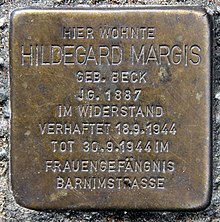Hildegard Margis
Hildegard Margis (born May 31, 1887 in Posen , † September 30, 1944 in Berlin ) was a German women's rights activist , author and resistance fighter against National Socialism .
Life
Hildegard Margis mother was of Jewish denomination, her father of Catholic denomination. She received training as a teacher. She married Paul Margis, who “fell” in the Verdun trenches at the end of the First World War. The death of her husband made her a declared war opponent.
As a widow, she initially lived on the verge of subsistence with two small children. With the help of her typewriter and a $ 5 loan, she quickly built a successful consumer advice company . She published a magazine for consumer information, from which the housekeeping purchase, advice and information service (Heibaudi) arose, the forerunner of today's consumer advice centers . The Heibaudi Association was taken over by the Nazi state bureaucracy, repurposed and later dissolved.
The political parties became aware of Hildegard Margis and her network of housewives much earlier. As early as the early 1920s, women became an important factor in electoral tactics through voting rights. Gustav Stresemann sought contact with Hildegard Margis and recruited her for the German People's Party . The place on the list intended for her was not enough for a mandate in the Reichstag , but Hildegard Margis became active in local politics. In spring 1922 she was elected to the district assembly of Berlin-Charlottenburg . She sat on the committees for health and nutrition and was responsible for the higher education institutions. In addition, she was elected to the board of numerous charitable organizations and a member of the Reich Economic Council.
In 1928, Hildegard Margis and the Deutsche Verlags-Anstalt founded the Hauswirtschaft publishing house , which edited cookbooks and expertises on household issues. In 1930 she signed a contract with Ullstein Verlag , she was given her own office space in the publishing house and published a number of texts on women's issues. She reported on the radio and in printed publications about "American measures to rationalize the budget".
When the Nazis came to power, they made sure that their children were safe. Her son Hans emigrated to London in 1936 and resisted by helping emigrants smuggle money and jewelry into London. As an “ Enemy Alien ” he was deported to Australia during the war and stayed there. Her daughter Hilde married the diplomat Sigismund von Braun and went to Addis Ababa . The "half-Jewish" Hildegard Margis got along badly with the von Brauns at first. After joining the Free Germany Movement , however, she sought contact with Magnus von Braun and his family in order to obtain information about their son Wernher von Braun and the Nazi missile program. She passed on the knowledge she gained about the construction of V weapons to Franz Jacob and Anton Saefkow . This information also reached Sweden via Arvid Lundgren , chauffeur at the Swedish embassy in Berlin .
Hildegard Margis was arrested on September 12, 1944. Twelve days later, she died in Barnimstrasse women's prison at the age of 57 as a result of torture by the Gestapo .
Hildegard Margis' grave is in the state-owned cemetery Heerstraße in Berlin-Westend . Grave location: 6-Cb-34.
Fonts (selection)
- (with Maria Jecker) The German cookbook. Frauendienst-Verlag: Berlin 1933
- (with Karl Mahler) Division and renovation of apartments. German publishing house: Stuttgart / Berlin 1932
- (Erna Meier) Get free at last - from household slavery! The simplified household and how to keep it up-to-date. Housewives, half the day is yours! Ullstein-Verlag: Berlin 1930
- Housewife and machine working together. Paris 1929
- The successful housewife. Berlin 1929
- Budget and economy. Advice on efficient housekeeping. Publication of German housewives: Berlin 1928
Honors
- In 2008, a stumbling block was laid in front of her last home on Lyckallee in Berlin-Charlottenburg .
literature
- Christina von Braun : Silent Mail. Another family story. Propylaea Published by Berlin 2007
- Annette Neumann, Susanne Reveles, Bärbel Schindler-Saefkow: Berlin workers' resistance 1942–1945. "Away with Hitler - end the war!" The Saefkow-Jacob-Bästlein-Organization. Berlin Association of Those Persecuted by the Nazi Regime - Bund der Antifaschisten und Antifaschistinnen eV: Berlin 2009, p. 51
Web links
- Stumbling blocks for the resistance organization Saefkow-Jacob-Bästlein ( Memento from June 6, 2009 in the Internet Archive )
- taz.de Article by Christina von Braun about her grandmother
- Germany radio culture
- Interview with Christina von Braun in: Friday July 6, 2007
Individual evidence
- ↑ Christina von Braun : Silent Mail. Another family story . Propylaea, Berlin 2008, ISBN 978-3-549-07314-8 . Pp. 164-165.
- ^ District Office Charlottenburg-Wilmersdorf
- ↑ Table of contents (PDF file; 101 kB)
| personal data | |
|---|---|
| SURNAME | Margis, Hildegard |
| BRIEF DESCRIPTION | German women's rights activist, author and resistance fighter against National Socialism |
| DATE OF BIRTH | May 31, 1887 |
| PLACE OF BIRTH | Poses |
| DATE OF DEATH | September 30, 1944 |
| Place of death | Berlin |

